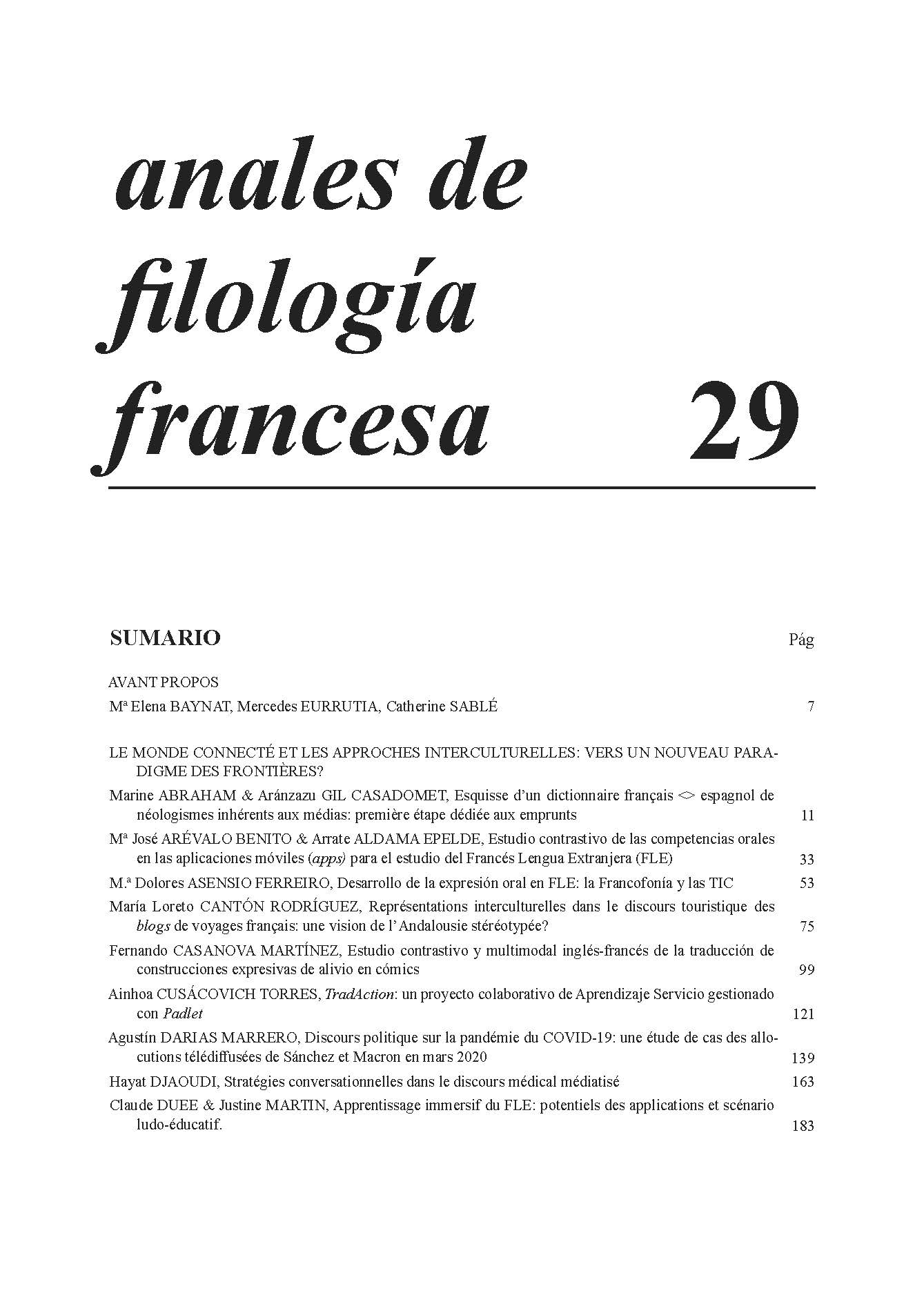Intercultural representataitons in the tourism discours of French travelling blogs: a stereotyped view of Andalusia ?
Abstract
The development of tourism discourse on the Internet has changed the way to design and sell the tourist product. In ten years, we have gone from talking about tourism 2.0 to tourism 4.0. This new discourse integrates oral and written discourse to persuade and convince the Internet tourist, who is now both transmitter and receiver of the same product. This new vision of the Other considered from the digital practice of travel blogs will be the subject of this contribution.
Firstly, we will offer a theoretical overview of this new tourism discourse, which has renewed the way of conceiving the image of a country and its identities, based on the opinion of these blogger-tourists. Our analysis will then focus on the vision of Andalusia drawn daily by these travelers in blogs, to verify whether the image conveyed is misleading, stereotyped or enhances unknown aspects of this region for the potential tourist.
Downloads
-
Abstract475
-
PDF (Français )687
References
Références Bibliographiques
AMOSSY, Ruth & Anne HERSCHEBERG PIERROT. 1997. Stéréotypes et clichés. Paris, Éditions Nathan.
BAIDER, Fabienne, BURGER, Marcel & Dionysis GOUTSOS. 2004. La communication touristique. Approches discursives de l’identité et l’altérité. Paris, l’Harmattan.
BUGNOT, Marie Ange. 2009a. “Estereotipia y localización en el discurso turístico” in Cédille. Revista electrónica de estudios franceses, nº 5, 56-80. <https://cedille.webs.ull.es/cinco/bugnot.pdf> [15/03/2021].
BUGNOT, Marie Ange. 2009b. Le discours touristique ou la réactivation du locus amoenus. Granada, Comares (col. Interlingua).
CALVI, Maria Vittoria. 2010. “Los géneros discursivos en la lengua del turismo: una propuesta de clasificación” in Ibérica, nº 19, 9-31: <http://www.aelfe.org/documents/01_19_Calvi.pdf> [22/02/2021].
CANTÓN RODRÍGUEZ, María Loreto. 2020. “Nuevos espacios del discurso turístico: identidad e imágenes de España a partir de los blogs de turismo franceses” in Baynat Monreal, María Elena, Mercedes Eurrutia Cavero & Cathy Sablé (eds.). Tic e Interculturalidad. Miradas cruzadas. Granada, Comares, 89-114 (col. Interlingua).
CHALLE, Odile. 2020. “L’interculturel. Une question de management international dans un monde connecté” in Baynat Monreal, María Elena, Mercedes Eurrutia Cavero & Cathy Sablé (eds.). Tic e Interculturalidad. Miradas cruzadas. Granada, Comares, 115-134 (col. Interlingua).
DESEILLIGNY, Oriane & Caroline ANGE. 2011. “Le maillage intertextuel des blogs de voyage” in Littérature et Communication, nº 33. Paris, L’Harmattan. 131-140.
DUFAYS, Jean-Louis. 1993 “Stéréotypes, lecture littéraire et postmodernisme ” in Plantin, Christian (ed.) Lieux communs, topoï, stéreotypes, clichés. Paris, Kimé. 61-102.
FEMENÍA MILLET, Olga 2011. La imagen de un destino turístico como herramienta de marketing. Málaga, Universidad de Málaga.
HIERNAUX-NICOLAS, Daniel, Allen CORDERO & Luisa VAN DUYNEN MONTIJN. 2002. Imaginarios sociales y turismo sostenible. Costa Rica, Facultad Latinoamericana de Ciencias Sociales: <http://www.danielhiernaux.net/publicaciones/index2.php> [24/04/2021].
LENDREVIE, Jacques & Julien Lévy. 2012. Mercator. Théories et nouvelles pratiques du marketing. Paris, Dunod.
LEVINE, Rick, Christopher LOCKE, Doc SEARLS, &David Weinberger. 1999. Le Manifeste de Cluetrain. Le manifeste des évidences: <https://www.cluetrain.com/manifeste.html> [24/04/2021].
LÓPEZ SANTIAGO, Mercedes. 2020. “Hacia la interculturalidad a través de las TIC en el ámbito del turismo: Estudio contrastivo (Español-Francés)” in Baynat Monreal, María Elena, Mercedes Eurrutia Cavero & Cathy Sablé (eds.). Tic e Interculturalidad. Miradas cruzadas. Granada, Comares, 223-248 (col. Interlingua).
MAHÉO, Claire & Nolwenn HÉNAFF. 2018. “L’offre touristique portée par les blogs : entre information, prescription et communication commerciale” in Aquilina, Manuelle, Claire Mahéo & Frédéric Pugnière-Saavedra (coord.). La communication touristique, vers des nouvelles interfaces ? Laval, Presses Universitaires de Laval, 143-167.
MAINGUENEAU, Dominique. 2007 [1998]. Analyser les textes de communication. Paris, Dunod.
MOURLHON-DALLIES, Florence. 2008. Enseigner une langue à des fins professionnelles. Paris, Didier.
MORFAUX, Louis Marie. 1980. Vocabulaire de la philosophie et des sciences humaines. Paris, Armand Colin.
UNESCO. 1982. “ Déclaration de Mexico sur les politiques culturelles. Conférence mondiale sur les politiques culturelles ”: [15/04/2021].
UNESCO. 2005. “La Convention de 2005 sur la protection et la promotion de la diversité des expressions culturelles”: <https://en.unesco.org/creativity/sites/creativity/files/2913_16_passport_web_f.pdf> [15/04/2021].
VERGOPOULOS, Hecate y Emilie FLON. 2012. “L’expérience touristique dans les guides: une subjectivité à lire, écrire et raconter” in Belgeo. Revue belge de Géographie. <http://journals.openedition.org/belgeo/7173> [15/03/2021].
VIALLON, Philippe. 2013. “La communication touristique, une triple invention” in Mondes du tourisme, 7: <http://tourisme.revues.org/171> [10/02/2021].
VIALLON, Philippe. 2018. “Le monde à portée de clic: la communication touristique en mutation ” in Aquilina, Manuelle, Claire Mahéo & Frédéric Pugnière-Saavedra (coord.). La communication touristique, vers des nouvelles interfaces? Laval, Presses Universitaires de Laval, 129-141.
VIALLON, Philipe & Sandrine HENNECKER. 2012. “La croyance à l’épreuve d’internet: qui croire, le site ou le blog touristiques?” in Recherches en communication, nº 38. <https://core.ac.uk/download/pdf/288193968.pdf> [10/02/2021].
Las obras que se publican en esta revista están sujetas a los siguientes términos:
1. El Servicio de Publicaciones de la Universidad de Murcia (la editorial) conserva los derechos patrimoniales (copyright) de las obras publicadas, y favorece y permite la reutilización de las mismas bajo la licencia de uso indicada en el punto 2.
2. Las obras se publican en la edición electrónica de la revista bajo una licencia Creative Commons Reconocimiento-NoComercial-SinObraDerivada 3.0 España (texto legal). Se pueden copiar, usar, difundir, transmitir y exponer públicamente, siempre que: i) se cite la autoría y la fuente original de su publicación (revista, editorial y URL de la obra); ii) no se usen para fines comerciales; iii) se mencione la existencia y especificaciones de esta licencia de uso.
3. Condiciones de auto-archivo. Se permite y se anima a los autores a difundir electrónicamente las versiones pre-print (versión antes de ser evaluada) y/o post-print (versión evaluada y aceptada para su publicación) de sus obras antes de su publicación, ya que favorece su circulación y difusión más temprana y con ello un posible aumento en su citación y alcance entre la comunidad académica. Color RoMEO: verde.










